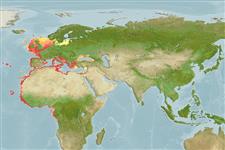Common names from other countries
Lớp phụ Cá sụn (cá mập và cá đuối) (sharks and rays) >
Myliobatiformes (Stingrays) >
Dasyatidae (Stingrays) > Dasyatinae
Etymology: Dasyatis: Greek, dasys = rough, dense (Ref. 45335).
More on author: Linnaeus.
Environment: milieu / climate zone / depth range / distribution range
Sinh thái học
Biển; Thuộc về nước lợ gần đáy; Mức độ sâu 5 - 200 m (Ref. 6808), usually 20 - 35 m (Ref. 27000). Subtropical; 61°N - 17°S, 32°W - 42°E
East Atlantic and the Mediterranean and Black Sea, from the North Sea to Angola.
Length at first maturity / Bộ gần gũi / Khối lượng (Trọng lượng) / Age
Maturity: Lm 54.3, range 41 - ? cm
Max length : 69.5 cm WD con đực/không giới tính; (Ref. 123699); Khối lượng cực đại được công bố: 10.2 kg (Ref. 123699)
A coastal species, which enters coastal lagoons, shallow bays and estuaries (Ref. 81259). Found over sandy and muddy bottoms, sometimes near rocky reefs (Ref. 12951). Feeds on bottom fishes, crustaceans and mollusks. Ovoviviparous, gestation period about 4 months and 4-7 young are produced. Wings marketed smoked, dried-salted, and also used for fishmeal and oil. Harmful to shellfish banks; dangerous to bathers and fishers due to its poisonous spine. Barbed poison spine is a modified denticle that can be 35cm long, shed occasionally and replaced (Ref. 35388). Maximum reported width about 150 cm (Ref. 81259).
Exhibit ovoviparity (aplacental viviparity), with embryos feeding initially on yolk, then receiving additional nourishment from the mother by indirect absorption of uterine fluid enriched with mucus, fat or protein through specialised structures (Ref. 50449). Distinct pairing with embrace (Ref. 205).
Bauchot, M.-L., 1987. Raies et autres batoides. p. 845-886. In W. Fischer, M.L. Bauchot and M. Schneider (eds.) Fiches FAO d'identificationpour les besoins de la pêche. (rev. 1). Mèditerranée et mer Noire. Zone de pêche 37. Vol. II. Commission des Communautés Européennes and FAO, Rome. (Ref. 3261)
IUCN Red List Status (Ref. 130435)
CITES (Ref. 128078)
Not Evaluated
Human uses
Các nghề cá: Tính thương mại; cá để chơi: đúng
Các công cụ
Special reports
Download XML
Các nguồn internet
Estimates based on models
Preferred temperature (Ref.
115969): 9.7 - 26.1, mean 12.2 (based on 352 cells).
Phylogenetic diversity index (Ref.
82804): PD
50 = 0.5002 [Uniqueness, from 0.5 = low to 2.0 = high].
Bayesian length-weight: a=0.00741 (0.00443 - 0.01240), b=2.99 (2.85 - 3.13), in cm Total Length, based on LWR estimates for this species & (Sub)family-body (Ref.
93245).
Mức dinh dưỡng (Ref.
69278): 4.1 ±0.63 se; based on food items.
Thích nghi nhanh (Ref.
120179): Rất thấp, thời gian nhân đôi của chủng quần tối thiểu là hơn 14 năm (Fec=4-7).
Fishing Vulnerability (Ref.
59153): Very high vulnerability (78 of 100).
Climate Vulnerability (Ref.
125649): Moderate to high vulnerability (55 of 100).
